Strategic Human Resource Management in Healthcare Institutions
VerifiedAdded on 2020/03/07
|9
|1803
|103
Report
AI Summary
This report provides an in-depth analysis of Human Resource Management (HRM) within hospital settings. It emphasizes the critical role of HRM in delivering efficient healthcare services, highlighting the importance of a proactive CEO and a dedicated HR department. The report details strategies for improving HRM practices, including the development of comprehensive HR policies, staffing strategies, performance management systems, training and development programs, personnel administration, and ensuring a safe work environment. It also examines the key features of building a sustainable HR capacity, focusing on staffing, performance management, training, personnel administration, and safety, and provides insights into creating a culture of continuous improvement and employee engagement to achieve the hospital's vision and objectives. The report includes references to support its findings and recommendations, making it a valuable resource for understanding and improving HRM in healthcare institutions.
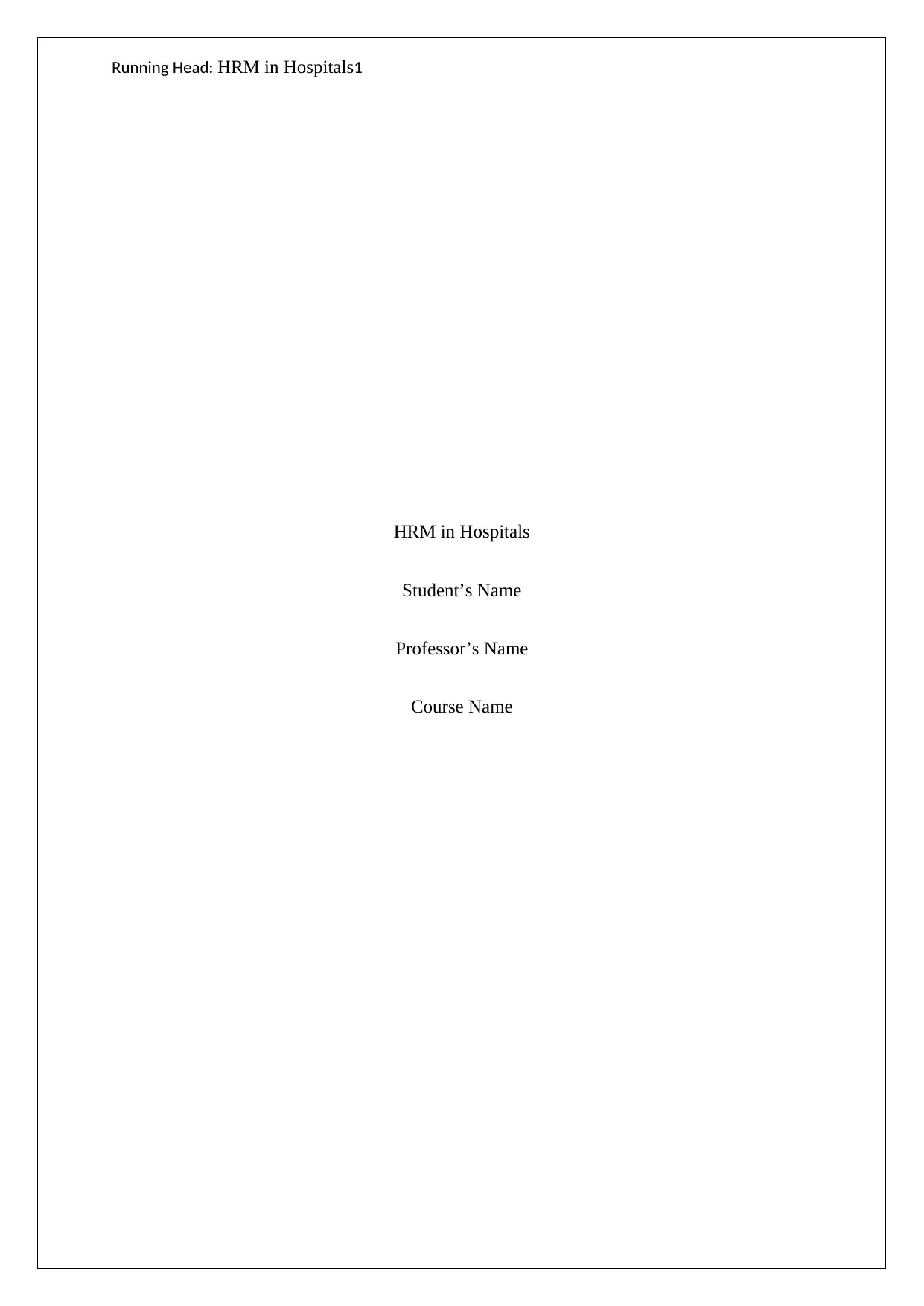
Running Head: HRM in Hospitals1
HRM in Hospitals
Student’s Name
Professor’s Name
Course Name
HRM in Hospitals
Student’s Name
Professor’s Name
Course Name
Paraphrase This Document
Need a fresh take? Get an instant paraphrase of this document with our AI Paraphraser
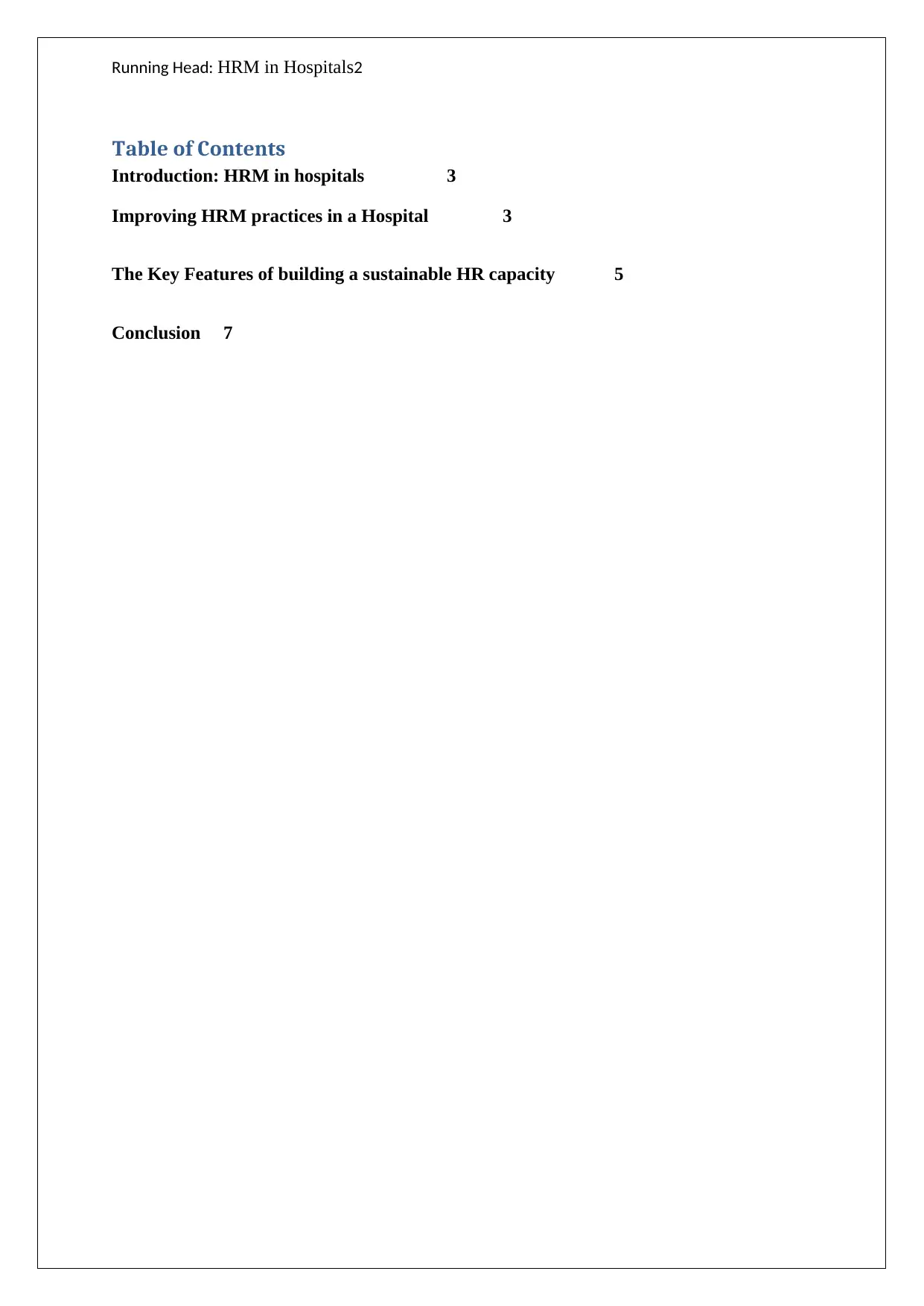
Running Head: HRM in Hospitals2
Table of Contents
Introduction: HRM in hospitals 3
Improving HRM practices in a Hospital 3
The Key Features of building a sustainable HR capacity 5
Conclusion 7
Table of Contents
Introduction: HRM in hospitals 3
Improving HRM practices in a Hospital 3
The Key Features of building a sustainable HR capacity 5
Conclusion 7
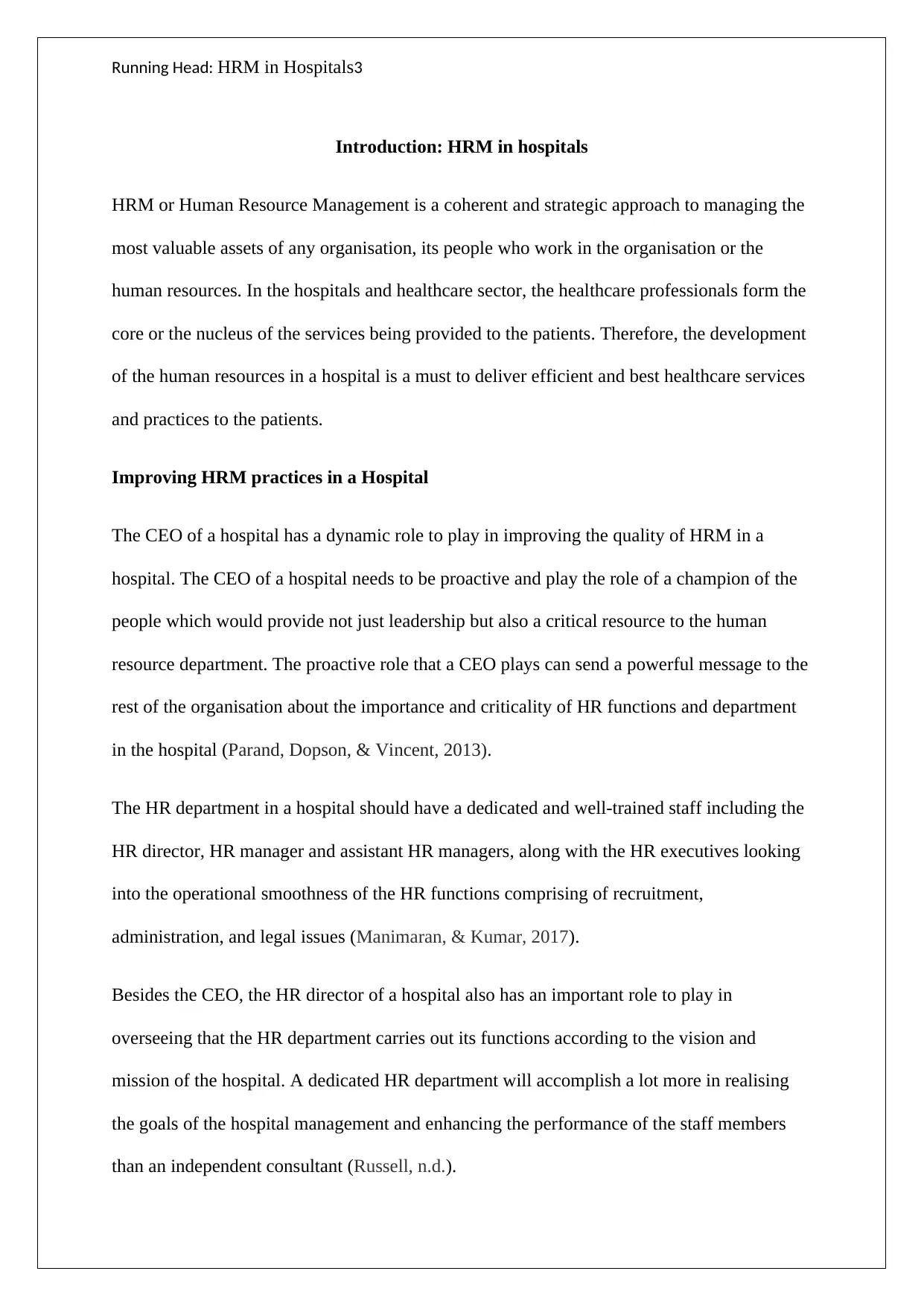
Running Head: HRM in Hospitals3
Introduction: HRM in hospitals
HRM or Human Resource Management is a coherent and strategic approach to managing the
most valuable assets of any organisation, its people who work in the organisation or the
human resources. In the hospitals and healthcare sector, the healthcare professionals form the
core or the nucleus of the services being provided to the patients. Therefore, the development
of the human resources in a hospital is a must to deliver efficient and best healthcare services
and practices to the patients.
Improving HRM practices in a Hospital
The CEO of a hospital has a dynamic role to play in improving the quality of HRM in a
hospital. The CEO of a hospital needs to be proactive and play the role of a champion of the
people which would provide not just leadership but also a critical resource to the human
resource department. The proactive role that a CEO plays can send a powerful message to the
rest of the organisation about the importance and criticality of HR functions and department
in the hospital (Parand, Dopson, & Vincent, 2013).
The HR department in a hospital should have a dedicated and well-trained staff including the
HR director, HR manager and assistant HR managers, along with the HR executives looking
into the operational smoothness of the HR functions comprising of recruitment,
administration, and legal issues (Manimaran, & Kumar, 2017).
Besides the CEO, the HR director of a hospital also has an important role to play in
overseeing that the HR department carries out its functions according to the vision and
mission of the hospital. A dedicated HR department will accomplish a lot more in realising
the goals of the hospital management and enhancing the performance of the staff members
than an independent consultant (Russell, n.d.).
Introduction: HRM in hospitals
HRM or Human Resource Management is a coherent and strategic approach to managing the
most valuable assets of any organisation, its people who work in the organisation or the
human resources. In the hospitals and healthcare sector, the healthcare professionals form the
core or the nucleus of the services being provided to the patients. Therefore, the development
of the human resources in a hospital is a must to deliver efficient and best healthcare services
and practices to the patients.
Improving HRM practices in a Hospital
The CEO of a hospital has a dynamic role to play in improving the quality of HRM in a
hospital. The CEO of a hospital needs to be proactive and play the role of a champion of the
people which would provide not just leadership but also a critical resource to the human
resource department. The proactive role that a CEO plays can send a powerful message to the
rest of the organisation about the importance and criticality of HR functions and department
in the hospital (Parand, Dopson, & Vincent, 2013).
The HR department in a hospital should have a dedicated and well-trained staff including the
HR director, HR manager and assistant HR managers, along with the HR executives looking
into the operational smoothness of the HR functions comprising of recruitment,
administration, and legal issues (Manimaran, & Kumar, 2017).
Besides the CEO, the HR director of a hospital also has an important role to play in
overseeing that the HR department carries out its functions according to the vision and
mission of the hospital. A dedicated HR department will accomplish a lot more in realising
the goals of the hospital management and enhancing the performance of the staff members
than an independent consultant (Russell, n.d.).
⊘ This is a preview!⊘
Do you want full access?
Subscribe today to unlock all pages.

Trusted by 1+ million students worldwide
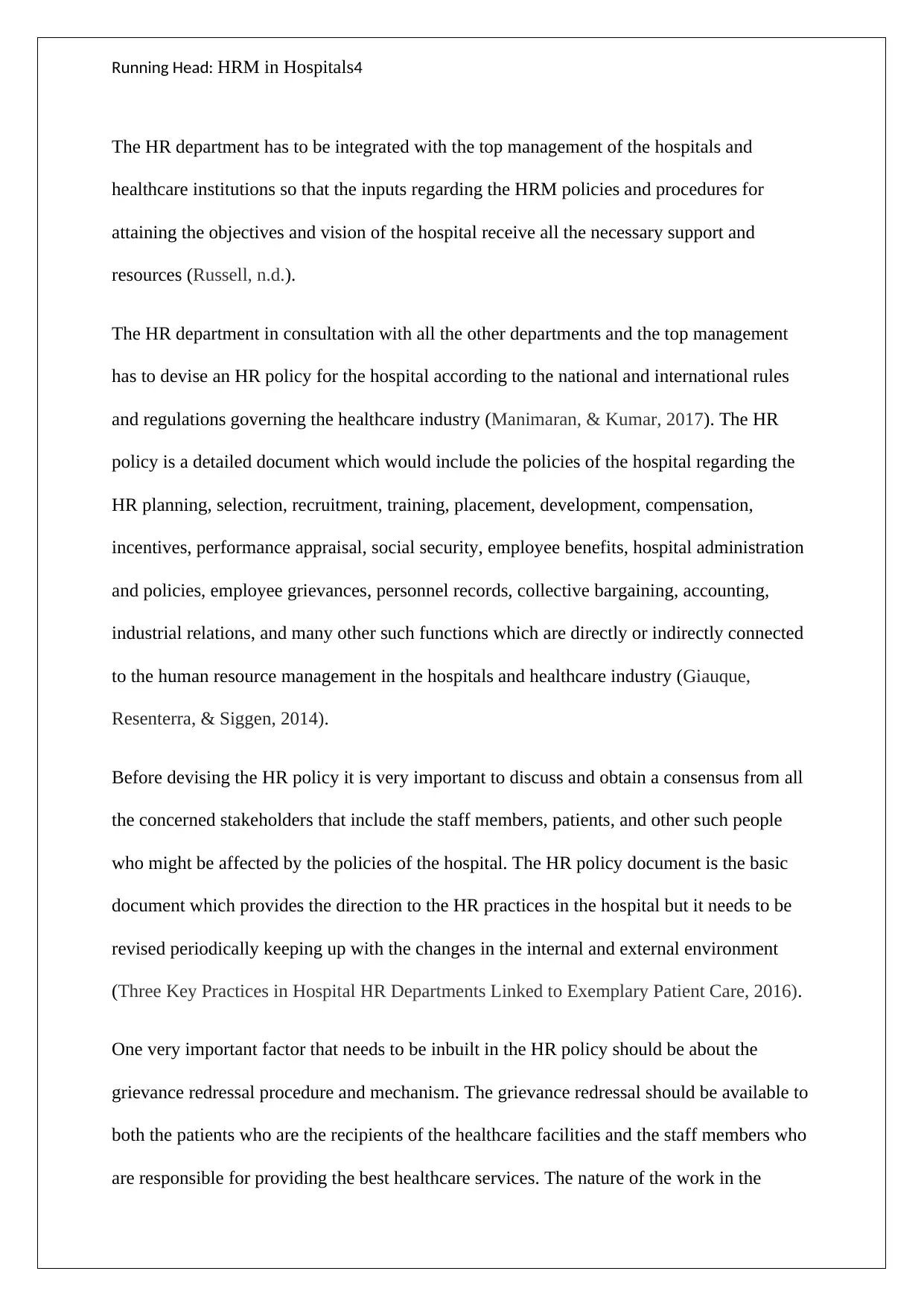
Running Head: HRM in Hospitals4
The HR department has to be integrated with the top management of the hospitals and
healthcare institutions so that the inputs regarding the HRM policies and procedures for
attaining the objectives and vision of the hospital receive all the necessary support and
resources (Russell, n.d.).
The HR department in consultation with all the other departments and the top management
has to devise an HR policy for the hospital according to the national and international rules
and regulations governing the healthcare industry (Manimaran, & Kumar, 2017). The HR
policy is a detailed document which would include the policies of the hospital regarding the
HR planning, selection, recruitment, training, placement, development, compensation,
incentives, performance appraisal, social security, employee benefits, hospital administration
and policies, employee grievances, personnel records, collective bargaining, accounting,
industrial relations, and many other such functions which are directly or indirectly connected
to the human resource management in the hospitals and healthcare industry (Giauque,
Resenterra, & Siggen, 2014).
Before devising the HR policy it is very important to discuss and obtain a consensus from all
the concerned stakeholders that include the staff members, patients, and other such people
who might be affected by the policies of the hospital. The HR policy document is the basic
document which provides the direction to the HR practices in the hospital but it needs to be
revised periodically keeping up with the changes in the internal and external environment
(Three Key Practices in Hospital HR Departments Linked to Exemplary Patient Care, 2016).
One very important factor that needs to be inbuilt in the HR policy should be about the
grievance redressal procedure and mechanism. The grievance redressal should be available to
both the patients who are the recipients of the healthcare facilities and the staff members who
are responsible for providing the best healthcare services. The nature of the work in the
The HR department has to be integrated with the top management of the hospitals and
healthcare institutions so that the inputs regarding the HRM policies and procedures for
attaining the objectives and vision of the hospital receive all the necessary support and
resources (Russell, n.d.).
The HR department in consultation with all the other departments and the top management
has to devise an HR policy for the hospital according to the national and international rules
and regulations governing the healthcare industry (Manimaran, & Kumar, 2017). The HR
policy is a detailed document which would include the policies of the hospital regarding the
HR planning, selection, recruitment, training, placement, development, compensation,
incentives, performance appraisal, social security, employee benefits, hospital administration
and policies, employee grievances, personnel records, collective bargaining, accounting,
industrial relations, and many other such functions which are directly or indirectly connected
to the human resource management in the hospitals and healthcare industry (Giauque,
Resenterra, & Siggen, 2014).
Before devising the HR policy it is very important to discuss and obtain a consensus from all
the concerned stakeholders that include the staff members, patients, and other such people
who might be affected by the policies of the hospital. The HR policy document is the basic
document which provides the direction to the HR practices in the hospital but it needs to be
revised periodically keeping up with the changes in the internal and external environment
(Three Key Practices in Hospital HR Departments Linked to Exemplary Patient Care, 2016).
One very important factor that needs to be inbuilt in the HR policy should be about the
grievance redressal procedure and mechanism. The grievance redressal should be available to
both the patients who are the recipients of the healthcare facilities and the staff members who
are responsible for providing the best healthcare services. The nature of the work in the
Paraphrase This Document
Need a fresh take? Get an instant paraphrase of this document with our AI Paraphraser
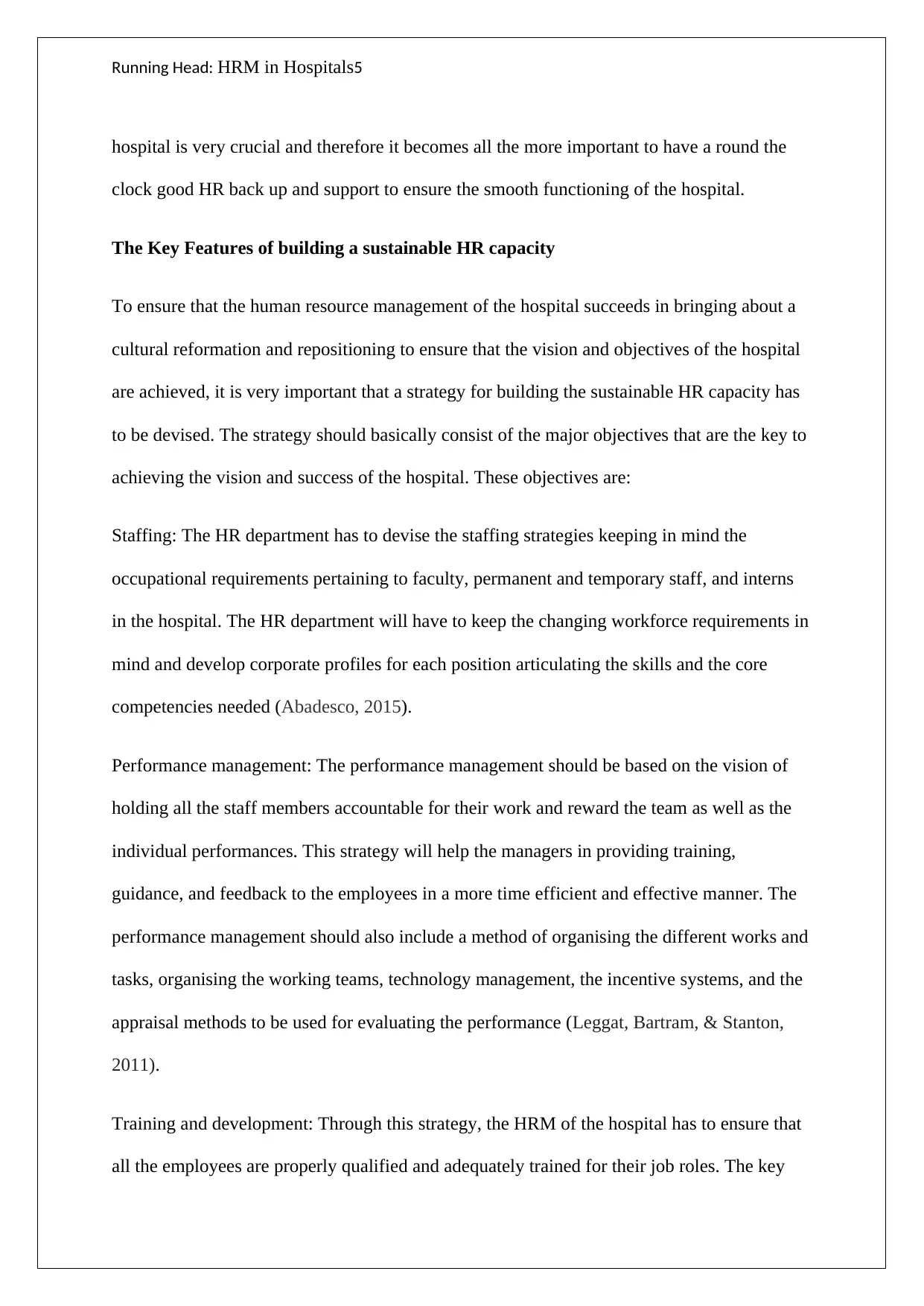
Running Head: HRM in Hospitals5
hospital is very crucial and therefore it becomes all the more important to have a round the
clock good HR back up and support to ensure the smooth functioning of the hospital.
The Key Features of building a sustainable HR capacity
To ensure that the human resource management of the hospital succeeds in bringing about a
cultural reformation and repositioning to ensure that the vision and objectives of the hospital
are achieved, it is very important that a strategy for building the sustainable HR capacity has
to be devised. The strategy should basically consist of the major objectives that are the key to
achieving the vision and success of the hospital. These objectives are:
Staffing: The HR department has to devise the staffing strategies keeping in mind the
occupational requirements pertaining to faculty, permanent and temporary staff, and interns
in the hospital. The HR department will have to keep the changing workforce requirements in
mind and develop corporate profiles for each position articulating the skills and the core
competencies needed (Abadesco, 2015).
Performance management: The performance management should be based on the vision of
holding all the staff members accountable for their work and reward the team as well as the
individual performances. This strategy will help the managers in providing training,
guidance, and feedback to the employees in a more time efficient and effective manner. The
performance management should also include a method of organising the different works and
tasks, organising the working teams, technology management, the incentive systems, and the
appraisal methods to be used for evaluating the performance (Leggat, Bartram, & Stanton,
2011).
Training and development: Through this strategy, the HRM of the hospital has to ensure that
all the employees are properly qualified and adequately trained for their job roles. The key
hospital is very crucial and therefore it becomes all the more important to have a round the
clock good HR back up and support to ensure the smooth functioning of the hospital.
The Key Features of building a sustainable HR capacity
To ensure that the human resource management of the hospital succeeds in bringing about a
cultural reformation and repositioning to ensure that the vision and objectives of the hospital
are achieved, it is very important that a strategy for building the sustainable HR capacity has
to be devised. The strategy should basically consist of the major objectives that are the key to
achieving the vision and success of the hospital. These objectives are:
Staffing: The HR department has to devise the staffing strategies keeping in mind the
occupational requirements pertaining to faculty, permanent and temporary staff, and interns
in the hospital. The HR department will have to keep the changing workforce requirements in
mind and develop corporate profiles for each position articulating the skills and the core
competencies needed (Abadesco, 2015).
Performance management: The performance management should be based on the vision of
holding all the staff members accountable for their work and reward the team as well as the
individual performances. This strategy will help the managers in providing training,
guidance, and feedback to the employees in a more time efficient and effective manner. The
performance management should also include a method of organising the different works and
tasks, organising the working teams, technology management, the incentive systems, and the
appraisal methods to be used for evaluating the performance (Leggat, Bartram, & Stanton,
2011).
Training and development: Through this strategy, the HRM of the hospital has to ensure that
all the employees are properly qualified and adequately trained for their job roles. The key
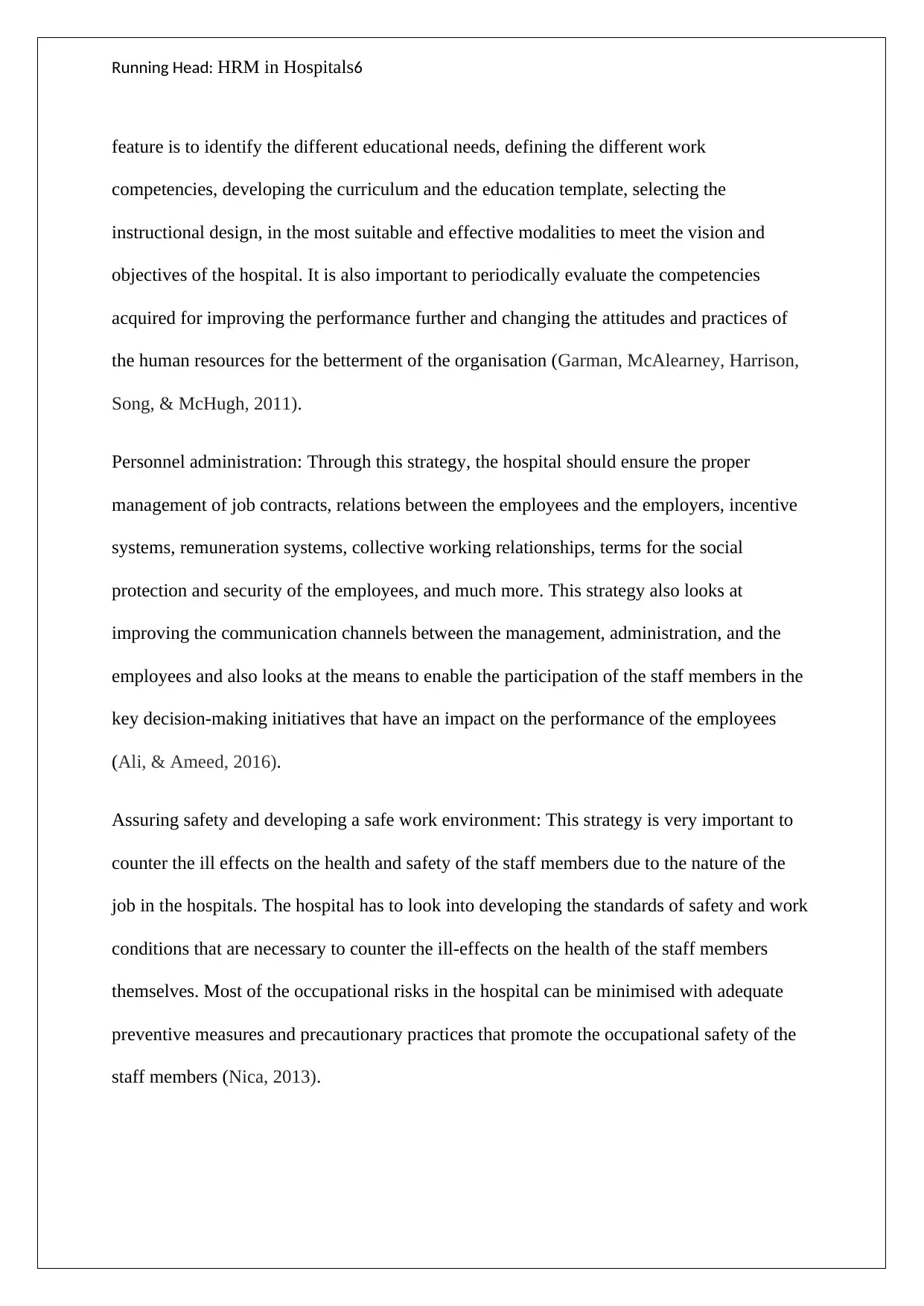
Running Head: HRM in Hospitals6
feature is to identify the different educational needs, defining the different work
competencies, developing the curriculum and the education template, selecting the
instructional design, in the most suitable and effective modalities to meet the vision and
objectives of the hospital. It is also important to periodically evaluate the competencies
acquired for improving the performance further and changing the attitudes and practices of
the human resources for the betterment of the organisation (Garman, McAlearney, Harrison,
Song, & McHugh, 2011).
Personnel administration: Through this strategy, the hospital should ensure the proper
management of job contracts, relations between the employees and the employers, incentive
systems, remuneration systems, collective working relationships, terms for the social
protection and security of the employees, and much more. This strategy also looks at
improving the communication channels between the management, administration, and the
employees and also looks at the means to enable the participation of the staff members in the
key decision-making initiatives that have an impact on the performance of the employees
(Ali, & Ameed, 2016).
Assuring safety and developing a safe work environment: This strategy is very important to
counter the ill effects on the health and safety of the staff members due to the nature of the
job in the hospitals. The hospital has to look into developing the standards of safety and work
conditions that are necessary to counter the ill-effects on the health of the staff members
themselves. Most of the occupational risks in the hospital can be minimised with adequate
preventive measures and precautionary practices that promote the occupational safety of the
staff members (Nica, 2013).
feature is to identify the different educational needs, defining the different work
competencies, developing the curriculum and the education template, selecting the
instructional design, in the most suitable and effective modalities to meet the vision and
objectives of the hospital. It is also important to periodically evaluate the competencies
acquired for improving the performance further and changing the attitudes and practices of
the human resources for the betterment of the organisation (Garman, McAlearney, Harrison,
Song, & McHugh, 2011).
Personnel administration: Through this strategy, the hospital should ensure the proper
management of job contracts, relations between the employees and the employers, incentive
systems, remuneration systems, collective working relationships, terms for the social
protection and security of the employees, and much more. This strategy also looks at
improving the communication channels between the management, administration, and the
employees and also looks at the means to enable the participation of the staff members in the
key decision-making initiatives that have an impact on the performance of the employees
(Ali, & Ameed, 2016).
Assuring safety and developing a safe work environment: This strategy is very important to
counter the ill effects on the health and safety of the staff members due to the nature of the
job in the hospitals. The hospital has to look into developing the standards of safety and work
conditions that are necessary to counter the ill-effects on the health of the staff members
themselves. Most of the occupational risks in the hospital can be minimised with adequate
preventive measures and precautionary practices that promote the occupational safety of the
staff members (Nica, 2013).
⊘ This is a preview!⊘
Do you want full access?
Subscribe today to unlock all pages.

Trusted by 1+ million students worldwide
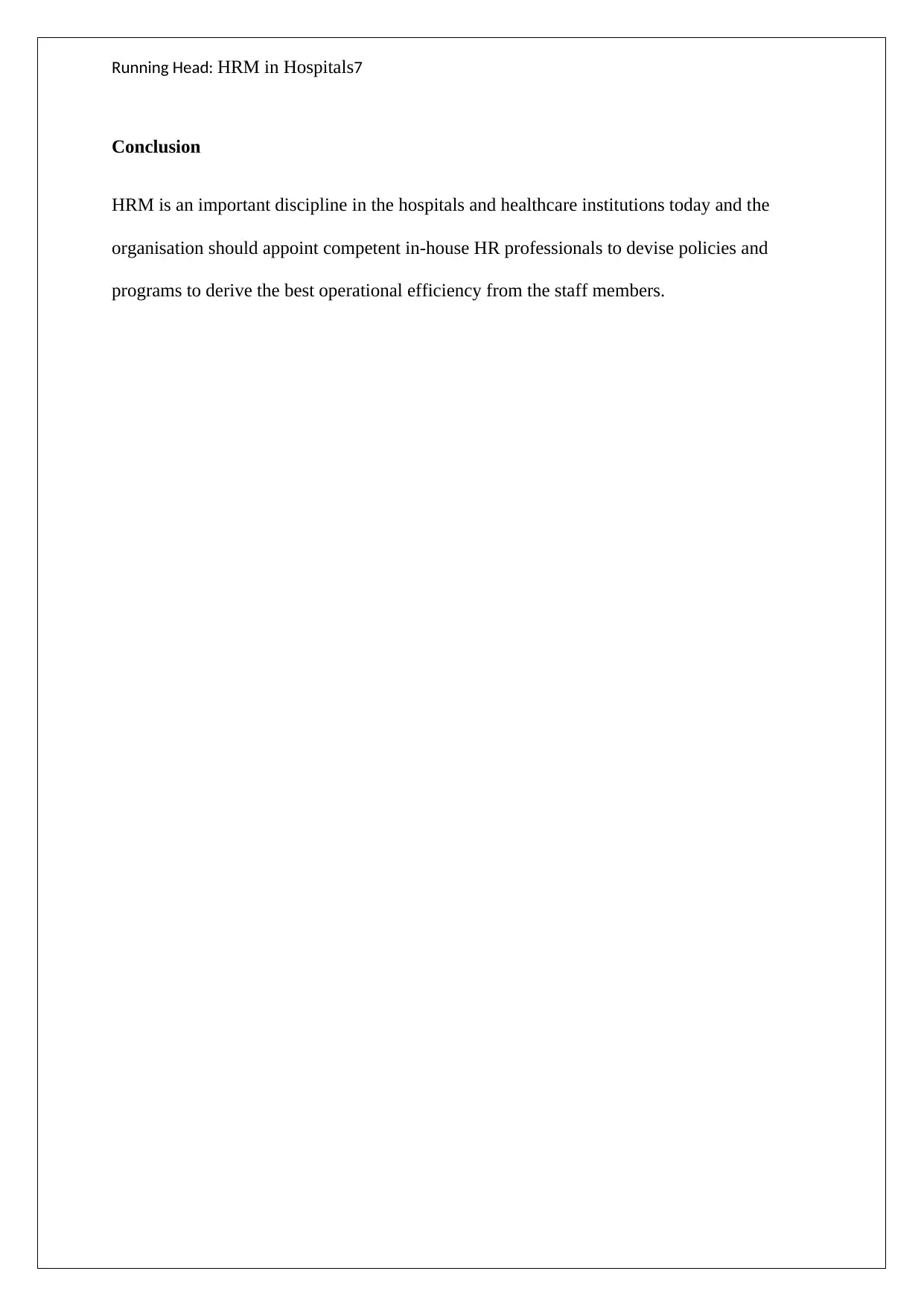
Running Head: HRM in Hospitals7
Conclusion
HRM is an important discipline in the hospitals and healthcare institutions today and the
organisation should appoint competent in-house HR professionals to devise policies and
programs to derive the best operational efficiency from the staff members.
Conclusion
HRM is an important discipline in the hospitals and healthcare institutions today and the
organisation should appoint competent in-house HR professionals to devise policies and
programs to derive the best operational efficiency from the staff members.
Paraphrase This Document
Need a fresh take? Get an instant paraphrase of this document with our AI Paraphraser

Running Head: HRM in Hospitals8
References:
Abadesco, E. V., Jr. (2015, November 22). Strategic HRM: Building organizational
capabilities. Retrieved from: http://business.inquirer.net/202970/strategic-hrm-building-
organizational-capabilities
Ali, E. M., Dr., & Ameed, S. A. (2016). HRM Issues and Challenges in
healthcare. INTERNATIONAL JOURNAL OF MANAGEMENT (IJM),7(2), 166-176.
Retrieved from:
http://www.iaeme.com/MasterAdmin/UploadFolder/IJM_07_02_019/IJM_07_02_019.pdf
Garman, A. N., McAlearney, A. S., Harrison, M. I., Song, P. H., & McHugh, M. (2011).
High-performance work systems in health care management, part 1: development of an
evidence-informed model. Health care management review, 36(3), 201-213.Retrieved from:
http://journals.lww.com/hcmrjournal/Abstract/2011/07000/High_performance_work_systems
_in_health_care.1.aspx
Giauque, D., Resenterra, F., & Siggen, M. (2014). Antecedents of job satisfaction,
organizational commitment and stress in a public hospital: a PE fit perspective. Public
Organization Review, 14(2), 201-228. Retrieved from:
https://link.springer.com/article/10.1007/s11115-012-0215-6
Leggat, S. G., Bartram, T., & Stanton, P. (2011). High performance work systems: the gap
between policy and practice in health care reform. Journal of Health Organization and
Management, 25(3), 281-297. Retrieved from:
http://www.emeraldinsight.com/doi/abs/10.1108/14777261111143536
References:
Abadesco, E. V., Jr. (2015, November 22). Strategic HRM: Building organizational
capabilities. Retrieved from: http://business.inquirer.net/202970/strategic-hrm-building-
organizational-capabilities
Ali, E. M., Dr., & Ameed, S. A. (2016). HRM Issues and Challenges in
healthcare. INTERNATIONAL JOURNAL OF MANAGEMENT (IJM),7(2), 166-176.
Retrieved from:
http://www.iaeme.com/MasterAdmin/UploadFolder/IJM_07_02_019/IJM_07_02_019.pdf
Garman, A. N., McAlearney, A. S., Harrison, M. I., Song, P. H., & McHugh, M. (2011).
High-performance work systems in health care management, part 1: development of an
evidence-informed model. Health care management review, 36(3), 201-213.Retrieved from:
http://journals.lww.com/hcmrjournal/Abstract/2011/07000/High_performance_work_systems
_in_health_care.1.aspx
Giauque, D., Resenterra, F., & Siggen, M. (2014). Antecedents of job satisfaction,
organizational commitment and stress in a public hospital: a PE fit perspective. Public
Organization Review, 14(2), 201-228. Retrieved from:
https://link.springer.com/article/10.1007/s11115-012-0215-6
Leggat, S. G., Bartram, T., & Stanton, P. (2011). High performance work systems: the gap
between policy and practice in health care reform. Journal of Health Organization and
Management, 25(3), 281-297. Retrieved from:
http://www.emeraldinsight.com/doi/abs/10.1108/14777261111143536

Running Head: HRM in Hospitals9
Manimaran, A., & Kumar, S. A. (2017, January 04). Human Resource Management in the
Healthcare Industry – A Literature Review. Retrieved from:
http://article.sciencepublishinggroup.com/html/10.11648.j.infomgmt.20160102.12.html
Nica, E. (2013). The importance of human resources management to the health care
system. Economics, Management and Financial Markets, 8(4), 166. Retrieved from:
https://www.questia.com/library/journal/1P3-3231345531/the-importance-of-human-
resources-management-to-the
Parand, A., Dopson, S., & Vincent, C. (2013). The role of chief executive officers in a quality
improvement initiative: a qualitative study. BMJ open, 3(1), e001731. Retrieved from:
http://bmjopen.bmj.com/content/3/1/e001731.short
Russell, A. (n.d.). The Role of HR Manager in Health Care. Retrieved from:
http://work.chron.com/role-hr-manager-health-care-19031.html
Three Key Practices in Hospital HR Departments Linked to Exemplary Patient Care. (2016,
November 07). Retrieved August 21, 2017, from
https://medicine.missouri.edu/2016/11/three-key-practices-in-hospital-hr-departments-linked-
to-exemplary-patient-care/
Manimaran, A., & Kumar, S. A. (2017, January 04). Human Resource Management in the
Healthcare Industry – A Literature Review. Retrieved from:
http://article.sciencepublishinggroup.com/html/10.11648.j.infomgmt.20160102.12.html
Nica, E. (2013). The importance of human resources management to the health care
system. Economics, Management and Financial Markets, 8(4), 166. Retrieved from:
https://www.questia.com/library/journal/1P3-3231345531/the-importance-of-human-
resources-management-to-the
Parand, A., Dopson, S., & Vincent, C. (2013). The role of chief executive officers in a quality
improvement initiative: a qualitative study. BMJ open, 3(1), e001731. Retrieved from:
http://bmjopen.bmj.com/content/3/1/e001731.short
Russell, A. (n.d.). The Role of HR Manager in Health Care. Retrieved from:
http://work.chron.com/role-hr-manager-health-care-19031.html
Three Key Practices in Hospital HR Departments Linked to Exemplary Patient Care. (2016,
November 07). Retrieved August 21, 2017, from
https://medicine.missouri.edu/2016/11/three-key-practices-in-hospital-hr-departments-linked-
to-exemplary-patient-care/
⊘ This is a preview!⊘
Do you want full access?
Subscribe today to unlock all pages.

Trusted by 1+ million students worldwide
1 out of 9
Related Documents
Your All-in-One AI-Powered Toolkit for Academic Success.
+13062052269
info@desklib.com
Available 24*7 on WhatsApp / Email
![[object Object]](/_next/static/media/star-bottom.7253800d.svg)
Unlock your academic potential
Copyright © 2020–2025 A2Z Services. All Rights Reserved. Developed and managed by ZUCOL.





